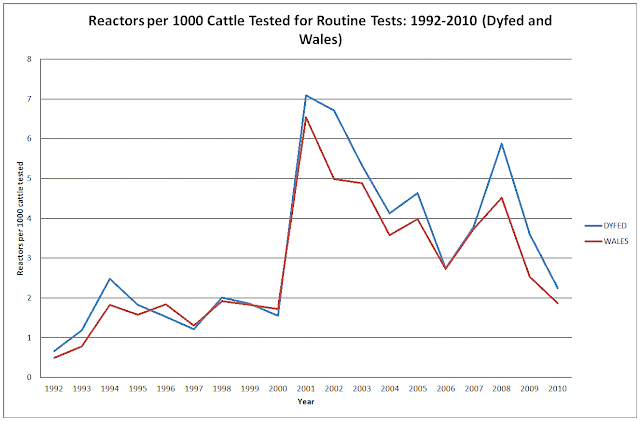Maps are powerful tools. They can be a great way of
presenting (or visualising as people like to call it these days) data and
statistics. But as geographers know, maps
are not always what they seem – and these maps (link no longer working) from Defra are a surprisingly
good example of that.
It all looks nice and shows the advance of TB across the
country – that part may be true. But actually, the maps are misleading. Here’s
why:
The maps are supposed to represent the number of cases of
TB. Only, the asterix tells us that it’s actually only about confirmed cases of
TB – that’s cases where visible lesions have been found. In the new even more confusing
jargon, these are “OTF withdrawn” cases. Or is it?
Below the picture you can see the number of reactors. Only,
this is the total number of reactors – not the number of confirmed reactors
(OTFW). Its a bit of a muddle – what is the map actually showing? If it’s about
confirmed cases then why not give the actual number of confirmed TB reactors? That
number would actually be a lot lower than the figures presented. I don’t have
the figures of confirmed reactors (i.e. reactors with visible lesions) to hand,
but for herd breakdowns figures show that around half are OTFW – although this
varies by region: in Dyfed OTFW breakdowns account for 36% of all breakdowns,
whilst in Gloucestershire its around 60% - quite an impressive difference
considering both are supposed to be high incidence areas.
Personally, I think this whole debate about
confirmed/unconfirmed reactors is not handled very well. Sometimes Government
likes to treat unconfirmed reactors in the same way as confirmed cases (as is
the case here), all go under TB restriction, and even when no visible lesions
are found, Government likes to tell farmers that doesn’t mean they don’t have
TB. At other times, they are treated separately – for example, the work on
badger culling ignores unconfirmed cases, AHVLA only visit farms to conduct
epidemiological investigation on confirmed cases, and the rules for going clear
are different. If one of the purposes of the change to the OTF jargon was to
help farmers understand the difference between confirmed and unconfirmed cases,
then I think that misses the point about the reasons why farmers distrust
science and the government.
Whatever the figures are, the shading on the maps is also
confusing. I’m bound to point this out as a geographer –the maps are committing
a gross ecological fallacy. Some of the later maps (2006, 2010) are essentially
suggesting that every farm in the south west is under TB restrictions. We know
this is not the case: even in the high incidence areas the number of breakdown
farms is relatively low: Defra’s own stats show that for last year the % of
herds with a confirmed (OTFW) breakdown is around 9% in Devon, 12% in
Gloucestershire, and 4% in Dyfed. When you look at the numbers of farms under
TB restrictions it’s higher, but not by too much: around 19% in Devon, 28% in
Gloucestershire and 14% in Dyfed. So to suggest that all farms in these areas
have TB as these maps do is misleading. But the maps also fail to distinguish
between high/low incidence areas of TB. For example, looking closely you might
think that an area like South Wales (low incidence) has the same kind of TB
problem as West Wales, where the problem is much greater.
None of this is to say of course that TB in these areas
isn’t a problem or needs to be reduced. It may also seem to be a bit of
pedantry – those “in the know” understand the limitations of presenting the
data in these ways. But this is the point: these maps aren’t meant for people
in the know: they are an exercise in communicating science to people “not in
the know”. And the main reason why you’d want to do that is to justify your
actions to those people – to convince them that what you are doing is
right. So they are not simply objective
representations: they have a purpose. Normally, in cases like these, I’d say
something like this is a good example of why people end up not trusting the
Government. However, there are similarities here with the use of statistics by
other organisations involved in TB: the NFUs public attitude survey and the
Badger Trust’s use of TB statistics being other examples. And when you take all
three cases together you can see there’s a wider purpose to the use of TB
statistics, found also in many other studies of policy making. Simply, it’s to
repeat a well known fact in policy studies: statistics help to objectify
claims, frame debate and advance the interests of different organisations.









